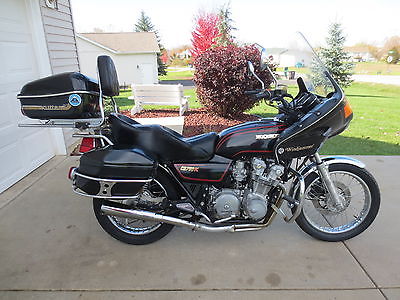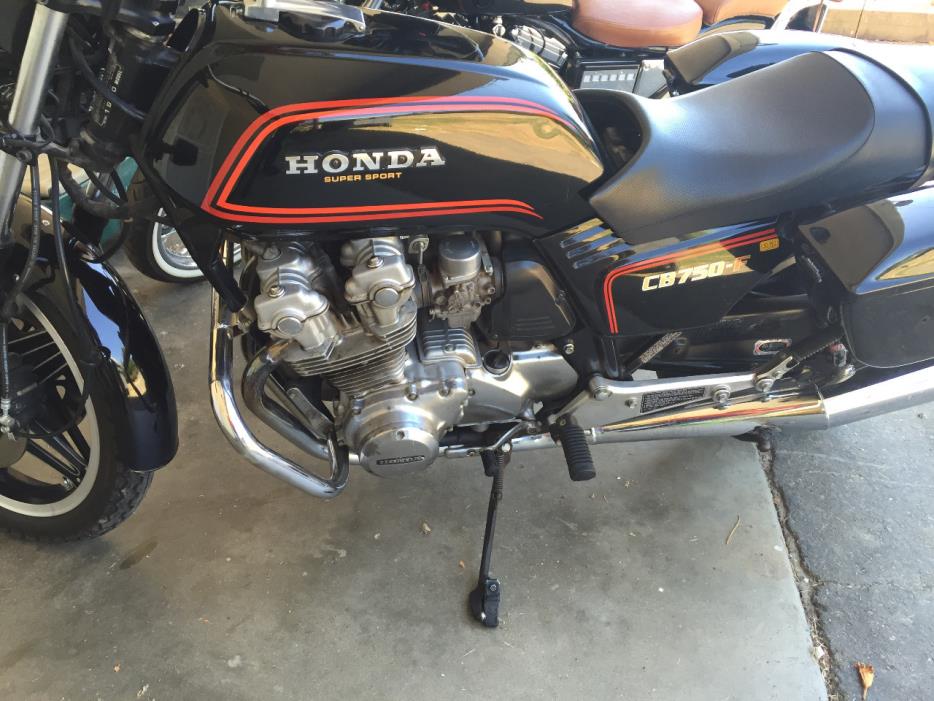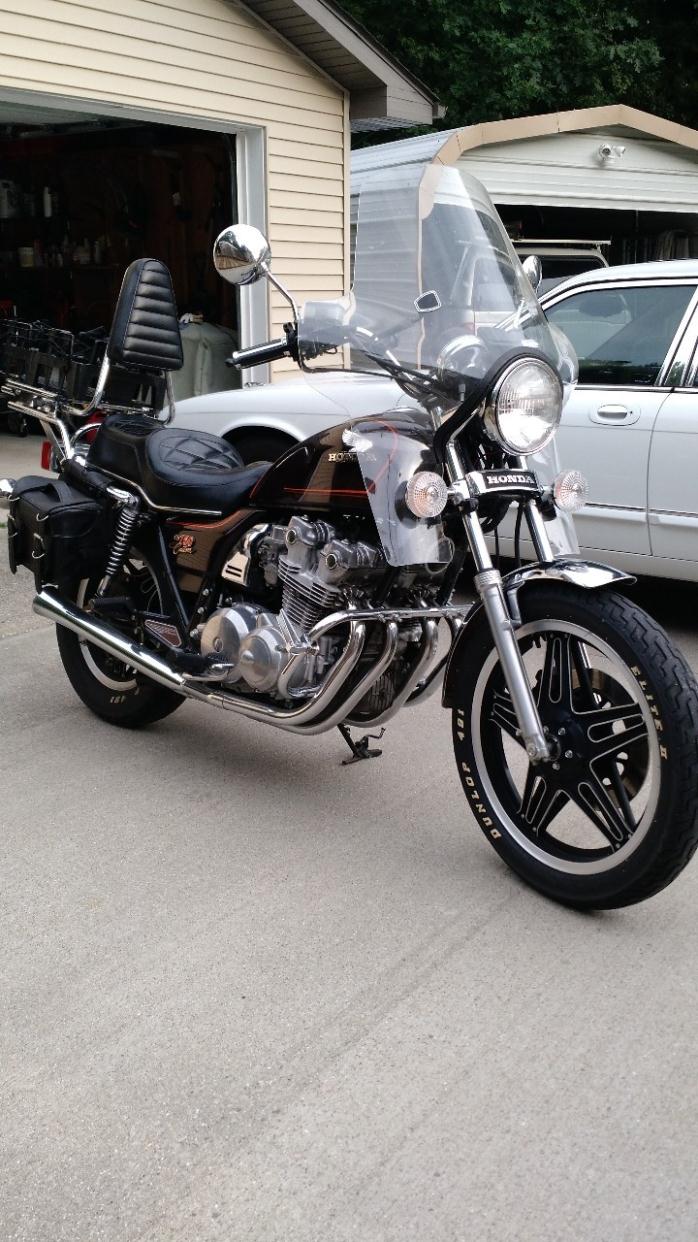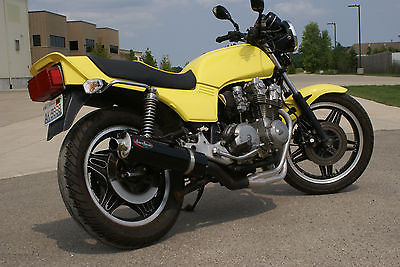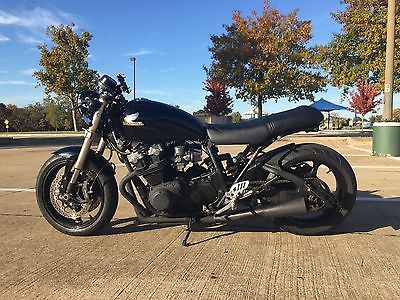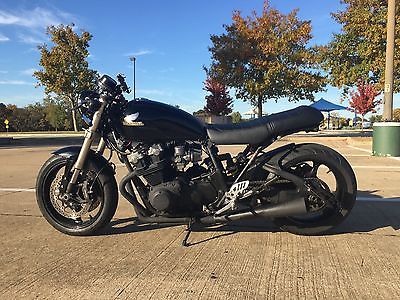$9,900
Chicago, Illinois
Category
-
Engine
-
Posted Over 1 Month
800x600 1975 HONDA CB750F SUPER SPORT – ALL ORIGINAL SURVIVOR! 3,126 ORIGINAL MILES, FRAME # CB750F-1007544, Manufactured 2/75 800x600 This Honda 750 Super Sport epitomizes the late 1970’s sportbike/cruiser that became a permanent part of Honda’s reputation and still represents the classic style… Please scroll past the description and terms for more photos! The condition of this machine is highly original and un-restored. It has 3,126 original miles from new. The frame and engine numbers are factory correct and original. It is the 750 cc engine. The gearbox is also original to the machine. This Honda 750 Super Sport is completely original and has never been apart. It is in un-restored and in very nice condition, and is a true historical document that should be preserved and ridden. This machine has been in my collection, is started on a regular basis, and ridden occasionally to make sure everything still works. When I purchased the bike, it had been sitting for some time in completely original condition. I went through the machine top to bottom and checked all of the major engine, transmission, and braking components for functionality and safety. The gas tank was still in beautiful condition, with no wear evident, the carburetors were inspected, cleaned, and re-installed, the air filter checked, all fluids changed, and both front and rear brakes were taken apart cleaned, re-built, and re-installed, the consequence of the bike sitting idle for a long period of time. The tires on the front and rear are the original type and size for the machine and appear to be the original tires to the machine. The tires and tubes have NOT been replaced and, while not as soft and pliable as when they were new, are in amazing original condition. The rims are also the original Honda rims, as are the spokes, and overall, the wheels are in very nice original condition. The seat is original and the upholstery is in perfect condition with no rips, tears, or wear of any kind, and the Honda script on the rear of the seat is sharp and clear. The engine and transmission are in excellent interior condition due to the low mileage and absence of any type of harsh conditions or abuse throughout its life. The 4 into 1 Honda exhaust is also original to the machine, and is in beautiful condition. A complete cleaning and detailing was performed, and although detailing on an original machine is never completed, the overall condition of the finishes is remarkable considering the age of the machine, and is in line with the low original mileage. The aluminum parts are in excellent condition overall, but due to the originality, I did not want to go too far polishing any parts. The paint is the original Candy Sapphire Blue, and is visually stunning. The original decals and badges are still applied to the gas tank, fairing and sidecovers. All of the plastic fairings, covers, etc. are in excellent condition and not in need of any type of repair. The 750 Super Sport on the road is very easy to handle, and rides down the road very tight, with no shakes, shimmies, or rattles. It shifts and accelerates smoothly and holds the road as it should. This bike is really great to ride and very fast for the period. There is absolutely NOTHING that needs to be done to this machine to ride it occasionally and enjoy it as a showpiece. Unlike a lot of collector motorcycles for sale on the internet, this 750 is ready to ride and not in need of any expensive service once you get it home. I am always looking for new machines to add to my collection. Please contact me if you have something interesting available! TERMS: $500 DEPOSIT WITHIN 48 HOURS OF AUCTION CLOSE. BALANCE OF AUCTION AMOUNT MUST BE PAID BY CASH IN PERSON, BANK TO BANK TRANSFER, OR CERTIFIED FUNDS (WITH VERIFICATION) ONLY WITHIN 7 DAYS OF AUCTION CLOSE. SORRY, NO C.O.D. AND NO PAYPAL. The description of this motorcycle is written to the best of my knowledge. However, I am by no means an expert on vintage Honda motorcycles. Please don’t hesitate to ask for more photos and, if possible, come and look in person before the auction ends. ALL SALES ARE FINAL! If you have any questions, please contact me before the auction ends. If you have any questions, please contact me. If you live close to Chicago, I encourage you to come and inspect the motorcycle in person! In an effort to protect the eBay user information and to help ensure the authenticity of correspondence between sellers and bidders, eBay’s new listing format does NOT display any bidder information. Nevertheless, I STRONGLY encourage bidders to contact me directly to answer questions or to verify correspondence. Seller reserves the right to not accept bids or sell the vehicle to anyone with a zero or negative eBay feedback rating. This motorcycle is being sold as is, where is with no warranty, expressed, written or implied. The seller shall not be responsible for the correct description, authenticity, genuineness, or defects herein, and makes no warranty in connection therewith. No allowance or set aside will be made on account of any incorrectness, imperfection, defect or damage. Any descriptions or representations are for identification purposes only and are not to be construed as a warranty of any type. It is the responsibility of the buyer to have thoroughly inspected the motorcycle and to have satisfied himself or herself as to the condition and value and to bid based upon that judgment solely. The seller shall and will make every reasonable effort to disclose any known defects associated with this motorcycle at the buyer's request PRIOR to the close of sale. Seller assumes no responsibility for any statements regardless of any oral statements about the motorcycle. Please remember that your bid constitutes a legally binding contract to purchase this item. If you require an inspection, have it done prior to bidding. I strongly encourage all bidders to inspect the motorcycle personally or enlist the services of a professional inspector prior to placing a bid. After the sale, inspections are not recognized as a contingency to completing your obligation to your winning bid. If there are any questions regarding the above terms, please e-mail prior to bidding. Please do not waste my time or yours bidding on an item you do not intend to pay for. If you bid on this item and win, you are expected to pay for the item and pick it up in a timely manner! I welcome ALL international bidders and am happy to assist with making shipping arrangements. I can also arrange crating for shipment on my end for a nominal extra charge. If you are an international buyer, I understand it can take some time to arrange shipping, so I do not mind keeping the motorcycle for a longer period of time until pick up. Please contact me before the sale ends, if possible, to discuss the specifics. Thanks for your interest! For more on the Honda 750 Super Sport, read on past the photos… 800x600 CB750F Super Sport History: Honda of Japan introduced the CB750 motorcycle to the US and European markets in 1969 after experiencing success with their smaller motorcycles. The bike was targeted directly at the US market after Honda officials, including founder Soichiro Honda, repeatedly met with US dealers and understood the opportunity for a larger bike. Under development for a year, the CB750 offered two unprecedented features, a front disc brake and a transverse straight-4 engine with an overhead camshaft, neither of which was previously available on a mainstream, affordable production bike. These two features, along with the introductory price of $1,495 ($9,475 in current money), gave the CB750 a considerable advantage over its competition, particularly its British rivals. Cycle magazine called the CB750 "the most sophisticated production bike ever" upon its introduction. Cycle World called it a masterpiece, highlighting Honda's painstaking durability testing, the bike's 120 mph (190 km/h) top speed, the fade-free performance of the braking, the comfortable ride and excellent instrumentation. The CB750 was the first modern four-cylinder machine from a mainstream manufacturer, and the term superbike was coined to describe it. The bike offered other important features that added to its compelling value: electric starter, kill switch, dual mirrors, flashing turn signals, easily maintained valves and overall smoothness and freedom from vibration both underway and at a standstill; later models (1991 on) included maintenance-free hydraulic valves. On the other hand, the bike was difficult to get on its center stand and tended to throw chain oil onto its muffler. Unable to gauge demand for the new bike accurately, Honda limited its initial investment in the production dies for the CB750 by using a technique called permanent mold casting (often erroneously referred to as sandcasting) rather than diecasting for the engines – the factory being unsure of the bike's reception. The bike remained in the Honda lineup for ten years, with sales totaling over 400,000 in its life span. The CB750 is sometimes referred to as a Universal Japanese Motorcycle or UJM. The Discovery Channel ranked the Honda CB750 third among the top ten greatest motorbikes of all time. Specifications: Claimed power: 58hp @ 8,000rpm Top speed: 114mph (period test) Engine: 736cc air-cooled SOHC transverse-mounted inline four Weight (dry): 449lb (227kg) Fuel capacity/MPG: 4.8gal / 35-55mpg Price then: $2,152 And more insight from articles on the 750 SS… The Honda CB750F Super Sport was born out of Honda's desire to regain its position as a motorcycle pacemaker. When Henry Ford launched the Model T in 1908, there was nothing else like it, and the T established a design template that defined the automobile for more than a decade. The problem? Ford was still building the T in 1928, and the market had moved on. By continuing to manufacture the same basic car, Ford maximized the benefits of mass production, but at the cost of market leadership. After years of snapping at Henry’s heels, the Dodge Brothers, Louis Chevrolet and the rest streaked out front. Something similar happened to Honda in the 1970s. The 1969 Honda CB750 Four mapped out the future for motorcycles. And like the Model T, it stayed in production for just a little too long. By 1975, the Kawasaki Z1 with its 903cc DOHC engine had leapfrogged ahead of the CB750. And waiting in the wings were The Suzuki GS750 and the Kawasaki KZ750, both aimed squarely at the market Honda had built, and creating along the way what was to become known as the Universal Japanese Motorcycle or UJM: the air-cooled, 2-valve, DOHC across-the-frame inline four. Honda’s response to the challenge was conservative. In 1975, the 750 K5 with its distinctive stacked mufflers was joined by the Honda CB750F Super Sport with a sportier 4-into-1 exhaust. The Honda CB750F also wore a new, slimmer-looking (but 0.3-gallon larger) gas tank with a recessed filler covered by a lockable plate, and a disc brake replaced the rear wheel’s mediocre drum brake. In spite of its radical-looking (for Honda) exhaust, changes to the basic 750 Four plot were minor. Reduced trail and a longer swingarm improved straight-line stability, while a stiffer frame and suspension changes improved handling in the corners. And although the engine was claimed to be unchanged, the new exhaust system brought minor adjustments to valve timing and carburetion, which, according to Cycle magazine, also eliminated the K-bike’s off-idle flat spot. Whether it was the new exhaust (and revised air box) or some undisclosed engine modifications, the F produced considerably more power than the K-bike. Cycle magazine recorded 58hp at the rear wheel compared with 49hp for the 1973 K3. This, combined with lower gearing, meant a standing quarter in the high 12s instead of the 13s. On the road, the improvements made for a comfortable ride and precise steering: “… it handles better than any of the other Japanese superbikes,” said Cycle. Fuel consumption was slightly worse at 43mpg versus the K’s 45mpg, perhaps because of the lower gearing and a 12-pound weight increase. Then the 1977 Honda CB750F2 Super Sport, the CB750F2, was introduced in 1977. The F2 featured Honda’s ComStar wheels with dual disc brakes at the front while the 4-into-1 exhaust exited through a new muffler with a slightly deeper exhaust note. Changes inside the engine (larger valves and more radical cams) improved power to around 60hp at the rear wheel, but at higher rpm (now 8,500 compared with the F’s 8,000rpm) and with the redline stretched to 9,500rpm. To emphasize its sportiness, the engine was powder coated black. At over 540 pounds with a half tank of gas, the F2 was also the heaviest 750 so far (with the exception of the 750A automatic), and 10 pounds heavier than the 4-pipe touring K model. Yet in spite of the extra weight, and the fact that the 28mm Keihins now had accelerator pumps, fuel consumption improved slightly to 45mpg. Most testers considered the F2 to be the best Honda 750 so far, the result of continual refinement and improvement that had created a comfortable, fine handling motorcycle with performance that just about kept pace with the GS750. All was not perfect in paradise, however. During a 10,000-mile extended test, Cycle Guide’s F2 dropped a valve, destroying a piston and the cylinder head. The cause, they speculated, was insufficient heat treatment of the valve. Testers also emphasized some problems with the 750’s transmission, notably missed shifts, false neutrals and a tendency to drop out of gear. Also noted was a lack of steering stability. The life of a test mule includes some pretty vigorous riding, and the dropped valve occurred after a series of full throttle drag strip takeoffs attempting to verify Honda’s claim that the F2 was capable of sub-13 second standing quarters. “We didn’t abuse the CB750,” concluded Cycle Guide’s review, “but we pushed it to its limits — and then just past.” Further, the F2’s ComStar wheels — light alloy rims riveted to pressed steel struts — were largely unloved. Honda claimed they embodied the advantages of both cast and spoke wheels without any of the disadvantages. Few liked the appearance of the struts or the rivets, and the latter would prove to be troublesome. Rivets can loosen over time, compromising the integrity of the wheels. If you’re considering buying any Honda with ComStar wheels, check them carefully. While used Super Sports aren’t exactly rare, good ones are. As the sportiest bike in Honda’s mid-1970s stable, they seem to have received more than their fair share of abuse, victims, perhaps, of over-enthusiastic owners. But parts are plentiful, and thanks to their simple build they’re easy to work on and generally hugely reliable, making them a great usable classic. MC Motorcycle Classics magazine, by Richard Backus, May/June 2010 It could certainly be argued, that the progenitor of the 1970s superbikes was the four-cylinder Honda CB750, a machine first introduced in 1969 and the precursor to the 1976 Honda CB750F Super Sport featured here. Honda definitely wowed the motorcycling community with the CB750, but it didn’t hold the top spot for long. By the time Honda was marketing the CB750 K4 in 1974, plenty of luster had worn off the model. For one thing, competing manufacturers were producing faster motorcycles — like the aforementioned Z1. And thanks to the 1973 Arab oil embargo, fuel economy had become an important concern in the North American market. In response, Honda detuned the CB’s 736cc power plant — increasing efficiency, but decreasing horsepower. Where the 1969 CB750 produced around 67 horses, for 1974 there were only about 50 ponies at the rear wheel. By comparison, the 1974 Z1 produced a claimed 82 horsepower. The CB750, once the lightning rod for a new generation of Superbikes, had suddenly become the old man in the group. Much of the performance market Honda had created was lost to them, and in 1975 Honda wasn’t even going to offer a standard CB750. Instead, Honda planned to spice things up by replacing the four-pipe CB750 with the 1975 Honda CB750F Super Sport. The Super Sport was an improved machine, complete with a four-into-one header and muffler system, revised frame geometry featuring a lengthened rear swingarm, a rear disc brake and a longer gas tank with a new seat and rear cowl. There were yet more changes. Honda returned some of the lost horsepower to the 736cc engine through various internal improvements, including an increased compression ratio (from 9:1 to 9.2:1) and revised cam timing. In Honda’s world, the Super Sport, with 58 horsepower, would be the company road burner while the newly introduced liquid-cooled, horizontally-opposed four-cylinder Honda GL1000 Gold Wing would take over as Honda’s big touring bike. CB loyalists weren’t going to let the four-pipe CB750 disappear, however, and for 1975 Honda ended up offering all three big models. Enter the Super Sport Marcos Markoulatos, a mechanic at Baron MINI in Merriam, Kan., is a fan of 1970s Japanese motorcycles. Born one year after the Honda CB750F Super Sport was introduced, Marcos got his first motorcycle, a 1984 Yamaha Maxim 700, when he was 22. He had put an extra $1,000 down on a house he and a friend were buying, and his friend gave him the Yamaha. And while the Yamaha was his first “motorcycle,” it definitely was not his first powered two-wheeler. When he was 14, and for the two years after, he could regularly be seen riding a Honda Express moped around his hometown. Marcos didn’t like the Maxim 700’s upright, cruiser-style handlebar, so he swapped it for a flat, straight drag bar and rode the Yam for three or four years. But then he discovered offroading and started spending more time playing with a Jeep, and the Maxim saw less and less use. It wasn’t long before the motorcycle was for sale. “I’d had my fun with the Yamaha, and even though it was a great bike, I wasn’t really in love with it,” Marcos says. A couple of years later, though, and Marcos was itching to ride again. “Motorcycling was something I couldn’t kick, and I started to look around on the Internet,” he explains. Not entirely sure what he was looking for, Marcos found himself researching 1970s Japanese motorcycles. “Japanese machines of that era seem to be plentiful and dependable — economical to own and purchase,” Marcos says. Eventually, he decided what he really wanted was a Suzuki GS1000S Wes Cooley Replica, a particularly rare machine manufactured for only two years, in 1979 and 1980. When Marcos couldn’t find one, he looked into building his own version of a Wes Cooley Replica, but learned that would be a costly proposition. And then, as fate would have it, he was talking motorcycles with a co-worker who said he had a 1972 Honda CB750K2 sitting in warehouse storage. It had been stored for 15 years, Marcos says, and he bought it for pennies on the dollar, but there was no title and the engine was stuck. None of that really worried Marcos, however, and he set about getting the Honda running, installing a used but clean set of Flame Sunrise Orange side covers and a matching gas tank. Marcos got the bike tuned up and ready to ride just in time to have to put it away for the winter late in 2008; he didn’t get to ride it until the spring of 2009. Lucking out In the interim, still searching Craigslist and other Internet sites, Marcos discovered our feature 1976 Honda CB750F Super Sport for sale in Chanute, Kan., just two hours southeast of his home in Lawrence, Kan. “Basically, I was addicted to searching Craigslist, and the (CB750F) was close and the price was right,” he says. At $1,800 the price wasn’t bottom dollar, but the seller was the second owner and the bike was obviously very well cared for. All of the factory decals are in place, the plastic lenses are crystal clear, and many of the yellow paint dots, applied at the factory during assembly, are still clearly visible on various nuts and bolts. Surprisingly, the CB750F gained some weight over the standard CB750 — a little bit more than 12 pounds. Yet a few extra pounds didn’t bother Cycle magazine’s tester, and they were quite happy with how the machine handled. In its May 1975 issue, Cycle said: “The CB750F, tighter gearing not withstanding, is going to get shaded in a straight-line contest of speed with, say a Z-1. But it handles better than any of the other Japanese Superbikes. Despite the longer wheelbase and stability-oriented steering geometry, the Honda CB750F handles like a bike at least a hundred pounds lighter.” Press Reports “The fact remains that it will just whip the tires off your typical, tricked-out café racer. Highbars, turn-indicators and all, it really is a super sporting motorcycle.” — Cycle, May 1975 “Performance-conscious riders will enjoy the added power and acceleration which have brought the machine back to the fringes of the Superbike category, with the added benefit of improved handling.” — Cycle Guide, July 1975 “It handles better than any other standard large Japanese bike I know, which makes it more fun than Honda 750s have ever been.” — Cycle World, November 1975 “The Honda 750F aims to please on too broad a scale to be a truly great motorcycle in any single category. But to label that as bad would go against the fact that Honda has a sold a huge number of K models since 1971.” — Rider, Winter 1976 “The acceleration, handling and braking are spirited enough to keep your adrenaline pumping.” — Cycle Guide, March, 1977 Normal 0 false false false EN-US X-NONE X-NONE MicrosoftInternetExplorer4 The Honda CB750F Super Sport was born out of Honda's desire to regain its position as a motorcycle pacemaker. When Henry Ford launched the Model T in 1908, there was nothing else like it, and the T established a design template that defined the automobile for more than a decade. The problem? Ford was still building the T in 1928, and the market had moved on. By continuing to manufacture the same basic car, Ford maximized the benefits of mass production, but at the cost of market leadership. After years of snapping at Henry’s heels, the Dodge Brothers, Louis Chevrolet and the rest streaked out front. Something similar happened to Honda in the 1970s. The 1969 Honda CB750 Four mapped out the future for motorcycles. And like the Model T, it stayed in production for just a little too long. By 1975, the Kawasaki Z1 with its 903cc DOHC engine had leapfrogged ahead of the CB750. And waiting in the wings were The Suzuki GS750 and the Kawasaki KZ750, both aimed squarely at the market Honda had built, and creating along the way what was to become known as the Universal Japanese Motorcycle or UJM: the air-cooled, 2-valve, DOHC across-the-frame inline four. Honda’s response to the challenge was conservative. In 1975, the 750 K5 with its distinctive stacked mufflers was joined by the Honda CB750F Super Sport with a sportier 4-into-1 exhaust. The Honda CB750F also wore a new, slimmer-looking (but 0.3-gallon larger) gas tank with a recessed filler covered by a lockable plate, and a disc brake replaced the rear wheel’s mediocre drum brake. In spite of its radical-looking (for Honda) exhaust, changes to the basic 750 Four plot were minor. Reduced trail and a longer swingarm improved straight-line stability, while a stiffer frame and suspension changes improved handling in the corners. And although the engine was claimed to be unchanged, the new exhaust system brought minor adjustments to valve timing and carburetion, which, according to Cycle magazine, also eliminated the K-bike’s off-idle flat spot. Whether it was the new exhaust (and revised air box) or some undisclosed engine modifications, the F produced considerably more power than the K-bike. Cycle magazine recorded 58hp at the rear wheel compared with 49hp for the 1973 K3. This, combined with lower gearing, meant a standing quarter in the high 12s instead of the 13s. On the road, the improvements made for a comfortable ride and precise steering: “… it handles better than any of the other Japanese superbikes,” said Cycle. Fuel consumption was slightly worse at 43mpg versus the K’s 45mpg, perhaps because of the lower gearing and a 12-pound weight increase.

